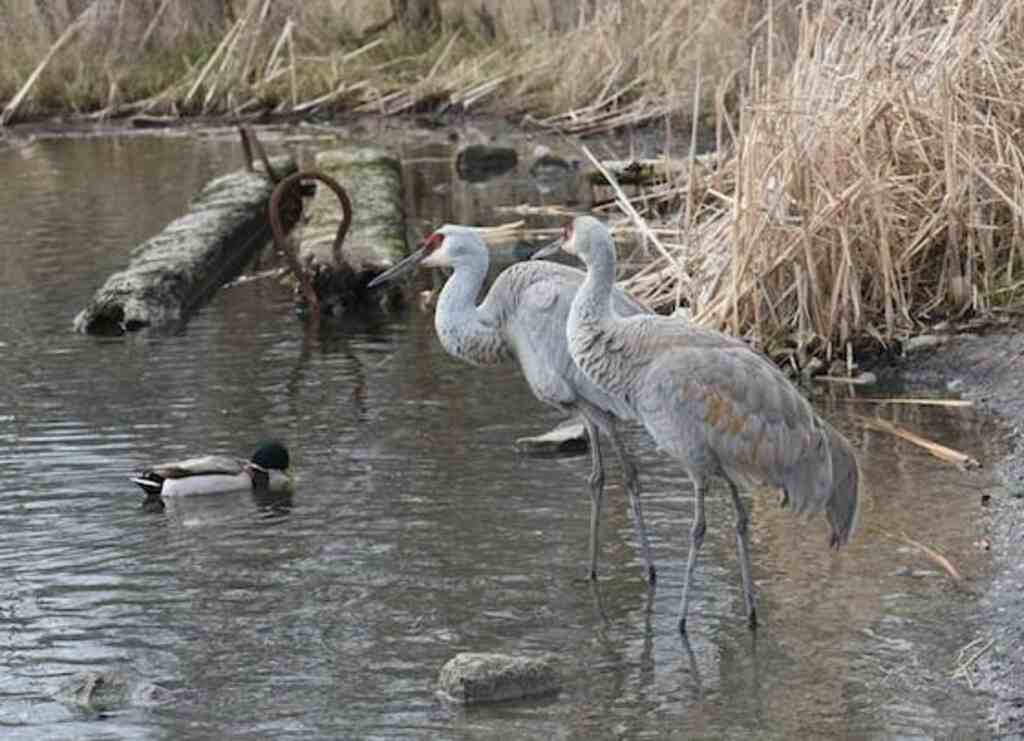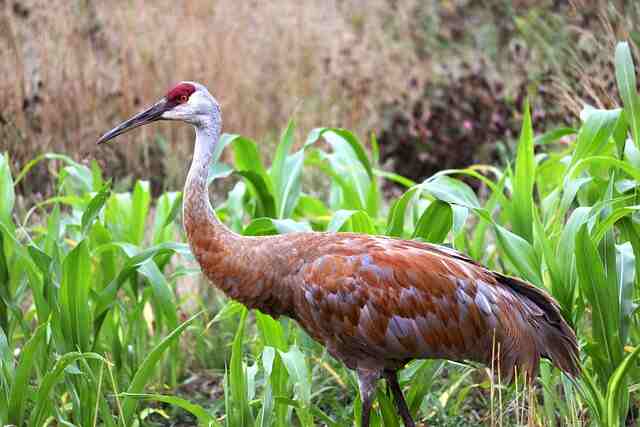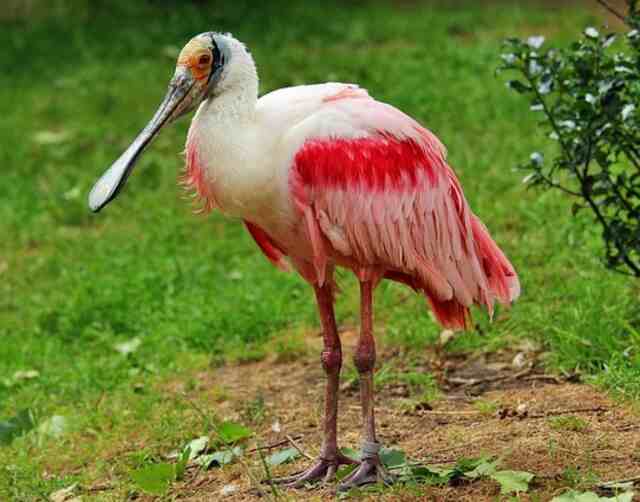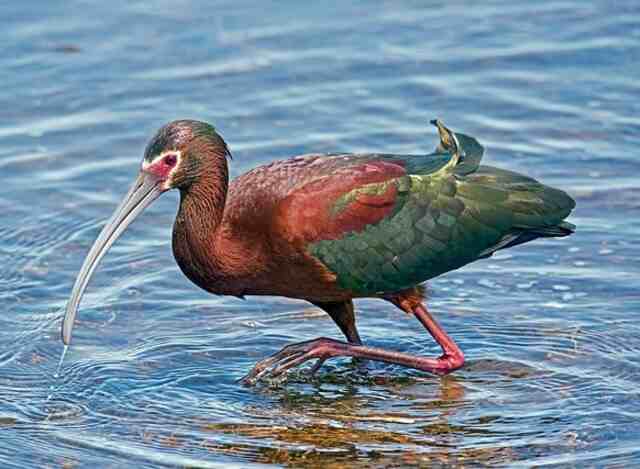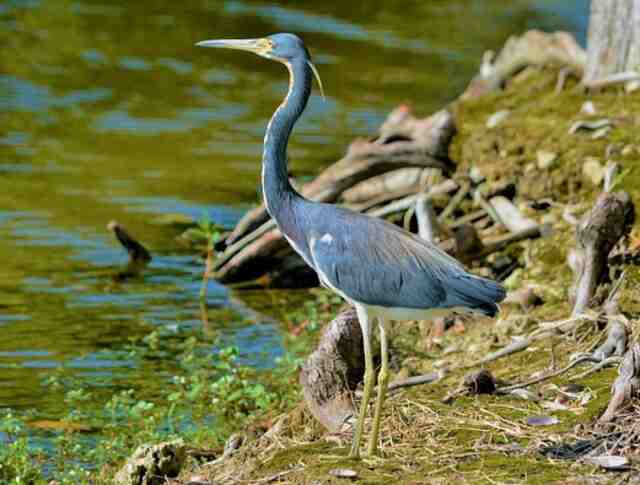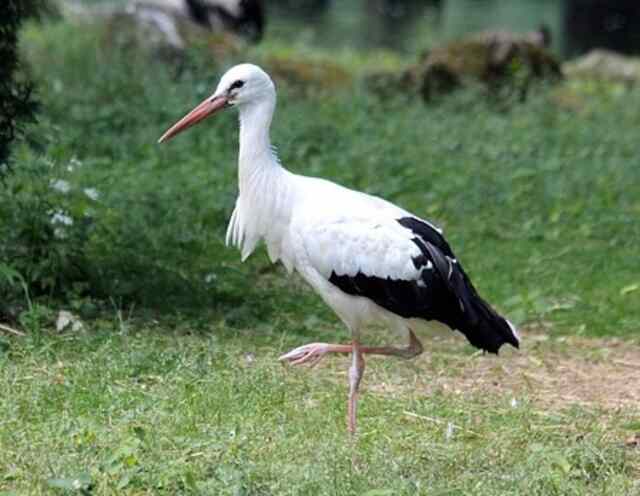Are you ready to meet the doppelgängers of the crane world? Look no further than these 15 birds that look like cranes in appearance, behavior, and even their characteristic calls.
From the long-necked heron to the colorful ibis, these birds share similar features with their crane counterparts, such as striking plumage, graceful movements, and a love for wetland habitats.
Join us on a journey to discover the fascinating world of crane lookalikes, and learn how to tell them apart from the real thing. Get ready to be amazed by these stunning birds and their uncanny resemblance to cranes!
Table of Contents [show]
Sandhill Crane (Overview)
| Characteristics | Distribution Range | Habitat | Diet | Size |
|---|---|---|---|---|
| Large, grayish-brown plumage with a distinctive red cap | North America, from Alaska to Florida | Wetlands, grasslands, and agricultural fields | Seeds, grains, insects, small animals, and aquatic plants | Height: 4-5 feet (1.2-1.5 meters), Wingspan: 6-7 feet (1.8-2.1 meters) |
Birds That Look Like Cranes
Great Blue Heron
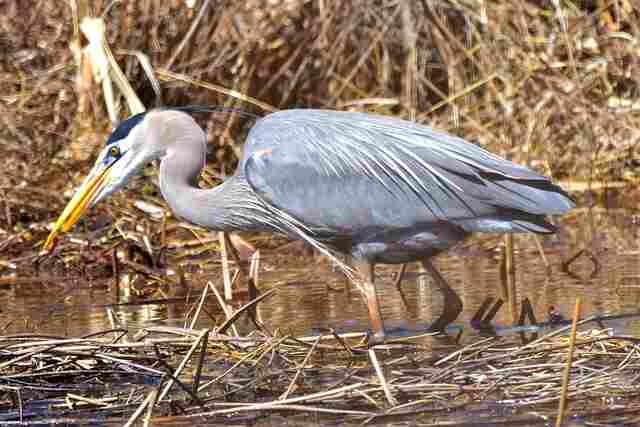
The Great Blue Heron, a regal bird of the Ardeidae family, is a sight to behold with its s-curved neck, long legs, massive wingspan, and signature blue-gray plumage. These birds are often found near bodies of water, ranging from freshwater marshes to coastal areas, and even urban settings. With their sharp eyesight, the great blue heron can spot prey from a distance, and their impressive fishing skills are unmatched.
They have been known to swallow prey whole, such as fish, eels, and even small mammals. In addition, the Great Blue Heron has been observed using tools, such as using bread as bait to catch fish. These intelligent birds are an iconic symbol of wetland ecosystems. Sandhill Cranes, a member of the Gruidae family, are often compared to the Great Blue Heron, as both are tall, elegant birds with long legs and necks.
However, Sandhill Cranes have a unique appearance with a red forehead, white cheeks, and gray plumage. They can be found across North America, with some populations wintering in Mexico and Cuba. Sandhill Cranes are omnivorous and feed on a variety of foods, from insects and small mammals to seeds and berries.
These birds are known for their elaborate mating dances, where they leap and bow, throwing their heads back and flapping their wings. Sandhill Cranes are an essential part of grassland ecosystems and are considered a symbol of luck and longevity in many cultures.
Roseate Spoonbill
The Roseate Spoonbill is a striking wading bird with a unique appearance. Its vivid pink plumage and spoon-shaped bill make it easily identifiable. The upper part of its body is white, while its wings and feathers underneath are a light shade of pink. This bird can grow up to 2.5 feet tall and has a wingspan of up to 4 feet.
It is found in marshy areas and mangroves in the southern parts of the United States. The Roseate Spoonbill feeds on a variety of prey, including minnows, small crustaceans, insects, and vegetation. In contrast, the Sandhill Crane is a taller bird that can grow up to 5 feet tall. It has a grayish-brown body with a distinct red cap on its head.
This bird can be found across North America and has a varied diet that includes seeds, insects, small mammals, and reptiles. Unlike the Roseate Spoonbill, the Sandhill Crane is not pink, but its feathers have a reddish tint.
It is adaptable to a variety of habitats, such as grasslands, wetlands, and agricultural fields. The Sandhill Crane is also known for its unique courtship dances and loud, trumpeting calls.
White-faced Ibis
The White-faced Ibis (Plegadis chihi) is a medium-sized wading bird found in North and Central America. These birds have a distinctive appearance, with a long curved bill, long legs, and glossy iridescent feathers that are greenish-purple in breeding adults and brownish-black in non-breeding adults. They prefer marshy wetlands, ponds, and grasslands for foraging and nesting.
The White-faced Ibis feeds mainly on insects, small fish, and other aquatic invertebrates, using their long bill to probe into the mud or shallow water to capture prey. In contrast, cranes are a family of large, long-legged, and long-necked birds found across the globe, from Africa to Asia to North America.
They have a distinctive trumpeting call and are known for their elaborate courtship displays during the breeding season. Cranes typically inhabit wetlands and grasslands, feeding on seeds, grains, small mammals, and invertebrates.
They are larger than the White-faced Ibis, with some species reaching up to 6 feet tall, and have a variety of colors and plumage, ranging from white to gray to brown. Despite these differences, both birds share a similar habitat and feeding behavior, relying on wetlands and grasslands for survival.
Great Egret
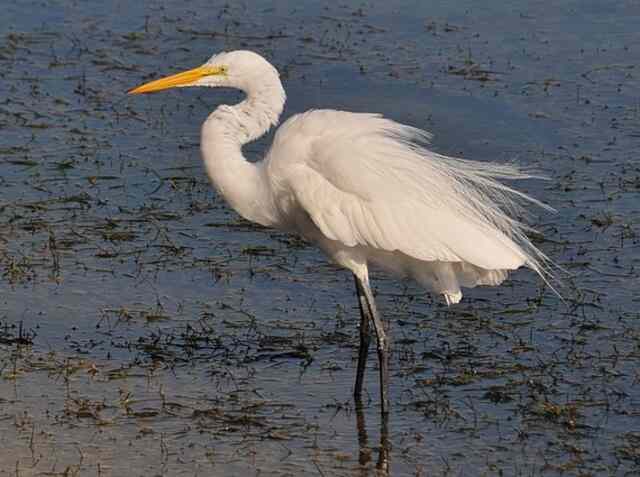
The Great Egret, also known as Ardea alba, is a majestic bird that stands out with its all-white plumage and long legs. These birds are over three feet tall, and their wingspan can reach almost five feet. They are commonly found in wetlands, swamps, marshes, and shallow water bodies throughout North and South America, Europe, Asia, Africa, and Australia.
Great Egrets feed on small fish, frogs, insects, and other aquatic creatures. They are skillful hunters and use their sharp beaks to spear prey in shallow waters. Sandhill Cranes and Great Egrets share some similarities, but also have distinctive differences. Sandhill Cranes are larger and have a more extensive wingspan than the Great Egret.
Unlike the Great Egret, Sandhill Cranes have grayish-brown feathers and a patch of red skin on their heads. Sandhill Cranes are found in open grasslands, wetlands, and agricultural fields across North America, while the Great Egret is more widespread across the world. Both species feed on similar diets, including small mammals, insects, and plants.
Sandhill Cranes are known for their elaborate dance rituals during mating season, while Great Egrets have long lacy plumes on their backs during the breeding season. Both birds are captivating to observe in their natural habitats, but they have unique characteristics that make them stand out.
Snowy Egret
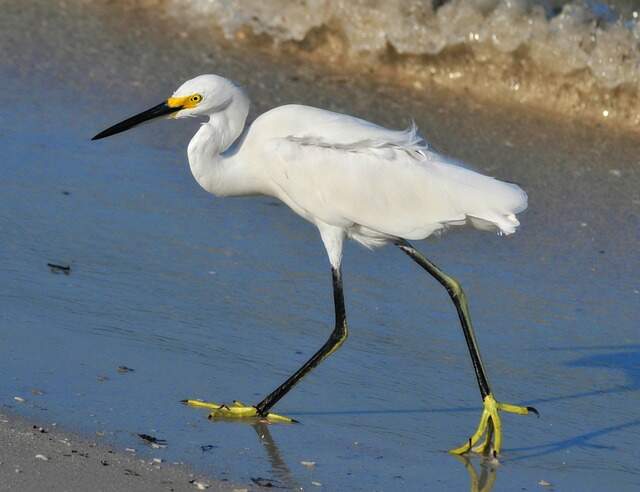
The Snowy Egret is a beautiful wading bird with distinct features. These birds are all-white with a black bills, black legs, and yellow feet. They have a patch of yellow skin at the base of the bill, which becomes brighter during the breeding season. Young Snowy Egrets have legs that are less bright and more greenish in color.
They are found throughout North, Central, and South America, primarily near shallow water bodies such as ponds, marshes, and coastal areas. Snowy Egrets feed on fish, insects, crustaceans, and other small aquatic animals, which they spear using their sharp bills while wading in shallow water.
Sandhill Cranes are large, gray-wading birds that are similar to Snowy Egrets in some ways but differ in many others. Sandhill Cranes are larger than Snowy Egrets, standing up to 4 feet tall, with a wingspan of up to 7 feet. They have a red forehead and a long, pointed bill.
They are found in open grasslands, wetlands, and agricultural areas throughout North America. Sandhill Cranes feed on a variety of plants and animals, including seeds, grains, insects, and small vertebrates. Unlike Snowy Egrets, Sandhill Cranes are primarily ground-dwellers and do not wade in shallow water to catch prey. They also have distinct courtship displays and migrate in large flocks.
Black-crowned Night-heron

The Black-crowned Night-heron is a wading bird found in North America, Europe, Asia, and Africa. These birds are recognizable by their black crown and back, gray wings, and a white underbelly. They measure about 64 cm in length with a wingspan of 115 cm.
The Black-crowned Night-heron primarily feeds on fish, amphibians, reptiles, and invertebrates such as crabs, crayfish, and insects. They prefer to reside near freshwater or brackish wetlands, such as ponds, marshes, and swamps. Sandhill Cranes are large, gray-wading birds found in North America, ranging from Canada to Mexico.
They are much larger than Black-crowned Night herons, reaching up to 152 cm in height with a wingspan of 213 cm. Sandhill Cranes have a distinctive red forehead patch and a long, pointed bill. They primarily feed on plant material, including grains, seeds, and berries, but will also eat insects, small mammals, and reptiles.
Sandhill Cranes prefer to live in open grasslands, wetlands, and agricultural fields. While both birds share similar habitat preferences, the Black-crowned Night heron is much smaller, primarily nocturnal, and feeds on different prey compared to Sandhill Cranes.
Tricolored Heron
The Tricolored Heron is a wading bird found along the coasts and marshes of the Americas. They are characterized by their dark-grayish-blue overall color with a white belly underneath the wings, and an extremely long bill. During the breeding season, they develop buff-colored plumes on their lower back and orange hues on their neck and throat.
Their diet mainly consists of small fish, crustaceans, and insects. They prefer to nest in tall shrubs and trees near water bodies. On the other hand, Sandhill Cranes are large birds found in wetlands, grasslands, and agricultural fields in North America. They are gray overall with a red forehead and white cheek patch.
They have long necks and legs, and their wingspan can reach up to seven feet. They consume grains, seeds, and insects as part of their diet. They are known for their distinctive “unison call” during mating season.
Unlike the Tricolored Heron, they prefer to nest on the ground. Both birds have different habitats, diets, appearances, and behaviors but are important members of their respective ecosystems.
Wood Stork
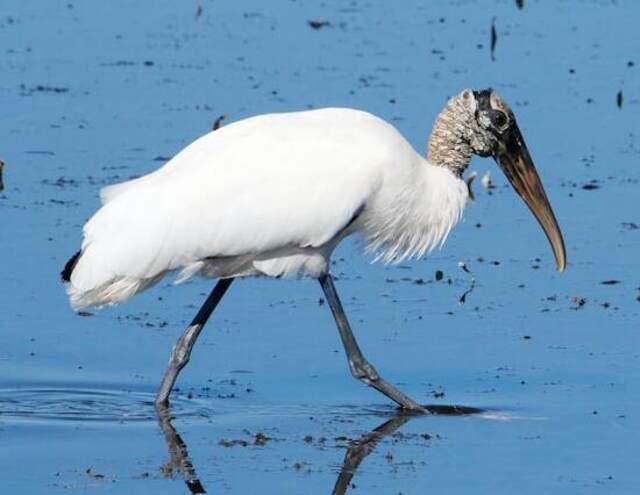
With its striking black-and-white plumage and long, graceful legs, the Wood Stork stands tall at just over three feet. Found primarily in the southeastern United States, as well as Central and South America, these elegant birds have distinctive bald, wrinkly heads and dark bills in adulthood, with young wood storks display lighter bills and untidy feathering on their neck and head..
Wood Storks primarily feed on fish, but they also consume crustaceans, amphibians, and insects. Their diet plays a critical role in sustaining the ecological balance of their wetland habitats. Sandhill Cranes, on the other hand, are majestic birds with gray plumage and a vibrant red patch on their head.
Standing up to five feet tall, these long-legged birds can be found in wetlands, grasslands, and agricultural fields throughout North America. While they share some habitat preferences with the Wood Stork, Sandhill Cranes are omnivores, dining on a diverse range of plants and animals, from grains to small mammals.
Sandhill Cranes are known for their elaborate courtship dances, a spectacle not seen in the less flashy Wood Storks. Despite their differences, both species play vital roles in their respective ecosystems, contributing to the complex web of life that supports our planet’s biodiversity.
Reddish Egret

The Reddish Egret is a large, wading bird found in the coastal regions of the Americas. These birds are characterized by their distinctive shaggy appearance, with a dark gray body, rusty colored head, and neck, grayish legs, and a black bill graduating to a pink bill base. They are known for their unique hunting behavior, where they run, dance, and jump around in shallow water to scare fish into their waiting bills.
Reddish Egrets can be found in saltwater and brackish marshes, lagoons, and estuaries, and they mainly feed on fish, shrimp, and crabs. Sandhill Cranes, on the other hand, are large, gray birds found in North America, with a wingspan of up to seven feet. Unlike Reddish Egrets, they are not wading birds but rather live in open grasslands, meadows, and wetlands.
Sandhill Cranes have a varied diet, consisting of seeds, grains, small mammals, and even snakes and frogs. They are also known for their distinctive courtship dance, which involves leaping, bowing, and wing flapping.
While both birds share a similar range in the Americas, the Sandhill Crane is significantly larger, with a more muted gray color and a longer neck. Overall, while both species are fascinating in their own right, they have very different appearances, habitats, and behaviors.
American White Ibis
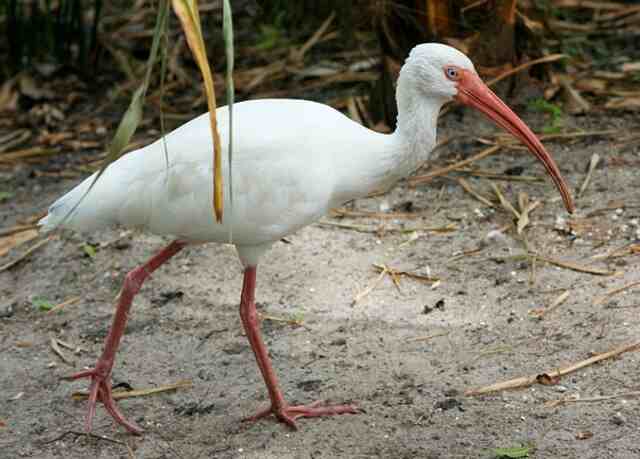
The American White Ibis (Eudocimus albus) is a wading bird found throughout the southeastern United States, and Central, and South America. It measures approximately 23 inches in length and has a wingspan of around 38 inches. Adults are mostly white with a small amount of black on the wingtips. The bill is reddish-purple, and the legs pink-red. The eyes are blue-colored, very large, and bright.
Youngsters are mostly brown with a little bit of white, and the wings are brown, white, and gray. They inhabit marshes, swamps, and shallow wetlands where they feed on aquatic animals such as small fish, crustaceans, and insects. Sandhill Cranes (Antigone canadensis) are large, long-legged birds that are found in North America.
They measure approximately 4 feet in height and have a wingspan of around 6-7 feet. They are grayish in color with a distinctive red patch on the crown of their head. They inhabit wetlands, grasslands, and agricultural fields where they feed on seeds, grains, and small animals such as frogs, snakes, and insects.
Unlike the American White Ibis, Sandhill Cranes are not predominantly white but instead have a grayish color. They are also much larger in size and have different diets and habitat preferences. However, both species are long-legged wading birds that inhabit wetland environments.
Eurasian Spoonbill
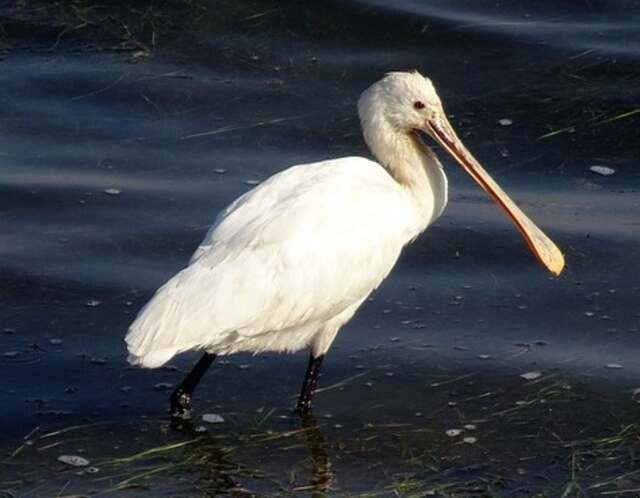
The Eurasian Spoonbill is a large, wading bird that is predominantly white in color with long black bills. It has a distinct, yellowish breast patch and an impressive white plume crest. Young Spoonbills have a paler bill and thin black wingtips that are only visible in flight. They can grow up to 80-90 cm in length and weigh around 2-2.5 kg.
Eurasian Spoonbills are found in a wide range, from Europe to Asia, and inhabit wetlands, marshes, and lagoons. They feed on a variety of small aquatic creatures such as fish, crustaceans, and insects. Sandhill Cranes, on the other hand, are large, grayish birds that can stand up to 1.2-1.5 meters tall and weigh around 3-5 kg.
They have a distinctive red forehead and a long neck with a distinctive downward bend. Sandhill Cranes are found in North America and parts of Siberia and breed in wetlands, marshes, and meadows. They feed on a diet of insects, rodents, small mammals, and plant matter.
Sandhill Cranes have a grayish plumage with reddish highlights, while Eurasian Spoonbills are mostly white in color. Both species exhibit unique and fascinating courtship displays during breeding season, but their behaviors and habitats are quite different.
White Stork
The White Stork (Ciconia ciconia) is a large wading bird with a wingspan of up to 2.4 meters and a height of up to 1 meter. It has mostly white plumage with black flight feathers and a distinctive long, conical, orange bill. Found in Europe, Asia, and Africa, the White Stork breeds in wetlands, marshes, and agricultural areas.
It feeds on a variety of prey, including small mammals, amphibians, insects, and reptiles. The bird is well-known for its distinctive nesting behavior, building large nests on tall structures like chimneys, poles, and trees. Sandhill Cranes (Grus canadensis) are large, gray wading birds that inhabit North America, Siberia, and Cuba.
They have a wingspan of up to 2.3 meters and can reach a height of up to 1.5 meters. Sandhill Cranes feed on insects, small mammals, reptiles, and amphibians. Their plumage is mostly gray with a reddish forehead, and they have a distinctive red patch on the crown of their head.
Unlike the White Stork, Sandhill Cranes are known for their loud and distinctive calls and form large flocks during migration. They typically build their nests in wetlands and marshes.
Gray Heron
The Gray Heron (Ardea cinerea) is a large wading bird found in Europe, Asia, and Africa. They stand around 90 to 100 cm tall, with a wingspan of up to 195 cm, and weigh around 1-2 kg. They have a distinctive long neck and bill, which they use to catch fish, amphibians, and other small prey in shallow water.
Gray Herons prefer wetlands, lakes, rivers, and estuaries as their habitat, and they often nest in tall trees near water. They are known for their ability to stand perfectly still for extended periods, waiting for prey to come within range.
In comparison, Sandhill Cranes (Grus canadensis) are large, long-legged wading birds found in North America, with a height of around 1-1.5 m and a wingspan of up to 2.5 m. They have a distinctive red patch on their head and gray feathers, with some rust-colored feathers on their wings.
Sandhill Cranes are omnivorous, feeding on seeds, insects, small mammals, and amphibians, and they prefer grasslands, wetlands, and agricultural fields as their habitat. Unlike the Gray Heron, Sandhill Cranes are known for their dancing and vocalization rituals during mating season.
Limpkin
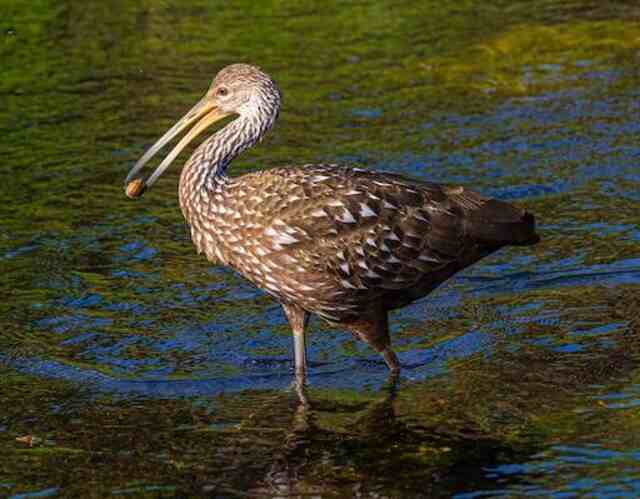
The Limpkin is a unique bird found primarily in the wetlands of Central and South America. It stands approximately 2 feet tall and weighs between 2-3 pounds. The bird’s most distinctive feature is its long, curved bill, which is perfectly suited for its primary diet of snails and mussels.
The Limpkin also feeds on other small aquatic animals and amphibians. The bird’s brown plumage is accented by white spots and streaks on its head and neck. Limpkins can be found in a range of wetland habitats, including marshes, swamps, and riverbanks.
The Sandhill Crane is a large, gray bird found throughout North America, as well as in parts of Siberia and Cuba. It stands approximately 4 feet tall and can weigh up to 10 pounds. Unlike the Limpkin, the Sandhill Crane has a straight, pointed bill and a distinctive red patch on its forehead.
While the Limpkin primarily feeds on snails and mussels, the Sandhill Crane has a varied diet that includes seeds, grains, insects, and small vertebrates. Both birds can be found in wetland habitats, but the Sandhill Crane is also known to inhabit grasslands and agricultural areas. Additionally, the Sandhill Crane is known for its elaborate mating rituals and distinctive, trumpet-like calls.
Whooping Crane
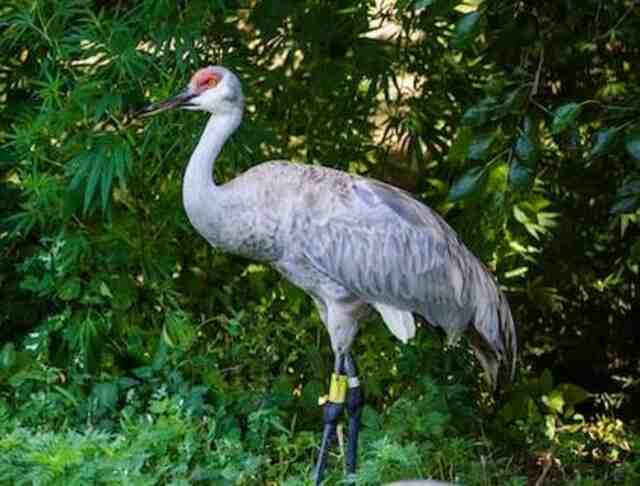
The Whooping Crane is a majestic bird that stands 5 feet tall with a wingspan of 7-8 feet, making it the tallest bird in North America. It is characterized by its distinctive whooping call and is one of the rarest birds in the world. Its range spans from Canada to Texas, where it breeds and feeds on aquatic plants, insects, and small animals.
It requires shallow wetlands as its habitat and is highly dependent on undisturbed areas for nesting. Compared to the Whooping Crane, the Sandhill Crane is slightly smaller, standing at 4-5 feet tall with a wingspan of 6-7 feet. Both species have similar range and habitat requirements, with the Sandhill Crane being more widespread and adaptable to different wetland types.
While both species have a similar diet, consisting of vegetation, insects, and small animals, the Sandhill Crane has a broader diet that includes grains and seeds.
In appearance, the Sandhill Crane has a grayish-brown plumage with a distinctive red cap but lacks the striking black and red markings of the Whooping Crane. Behavioral differences include the Sandhill Crane’s tendency to gather in large flocks and perform elaborate courtship dances.
Related Post: 52 Fun Facts About Sandhill Cranes (Test Your Knowledge!)

